 physical analog
physical analog
hover to animate -- input script
 physical analog
physical analog
![[new]](images/new.gif) The Ninth LAMMPS Workshop and Symposium was held August 12-14, 2025 in Albuquerque, NM, USA. See details here.
The Ninth LAMMPS Workshop and Symposium was held August 12-14, 2025 in Albuquerque, NM, USA. See details here.
![[new]](images/new.gif) There is a new LAMMPS overview
paper which you can cite in your publications. See
citation details here and
cool images here.
There is a new LAMMPS overview
paper which you can cite in your publications. See
citation details here and
cool images here.
| Big Picture | Code | Documentation | Results | Related Software | Context | User Support |
| Features | Download | Manual | Publications | Pre/Post processing | Authors | MatSci forum |
| Non-features | GitHub | Programmer guide | Picture gallery | External packages & tools | History | Slack channel |
| Packages | Latest features & bug fixes | Tutorials | Movie gallery | Pizza.py toolkit | Funding | Workshops |
| FAQ | Report bugs & request features | MD to LAMMPS glossary | Benchmarks | Visualization | Open source | Books about MD |
| Wish list | . | Commands | Citing LAMMPS | Other MD codes | Contribute to LAMMPS | . |
LAMMPS is a classical molecular dynamics code with a focus on materials modeling. It's an acronym for Large-scale Atomic/Molecular Massively Parallel Simulator.
LAMMPS has potentials for solid-state materials (metals, semiconductors) and soft matter (biomolecules, polymers) and coarse-grained or mesoscopic systems. It can be used to model atoms or, more generically, as a parallel particle simulator at the atomic, meso, or continuum scale.
LAMMPS runs on single processors or in parallel using message-passing techniques and a spatial-decomposition of the simulation domain. Many of its models have versions that provide accelerated performance on CPUs, GPUs, and Intel Xeon Phis. The code is designed to be easy to modify or extend with new functionality.
LAMMPS is distributed as an open source code under the terms of the GPLv2. The current version can be downloaded here. Links are also included to older versions. All LAMMPS development is done via GitHub, so all versions can also be accessed there.
The main authors of LAMMPS can be contacted via email to "developers at lammps.org" and are listed individually on this page along with contact info and other contributors. Funding for LAMMPS development has come primarily from the US Deparment of Energy (OASCR, OBER, ASCI, LDRD, ECP, Genomes-to-Life) and is acknowledged here.
 LAMMPS received an R&D 100 award
in 2018. Click here for more info and a video.
LAMMPS received an R&D 100 award
in 2018. Click here for more info and a video.
 (7/25) New stable release,
22Jul2025 version. See details
here
(7/25) New stable release,
22Jul2025 version. See details
here
 (8/24) New stable release,
29Aug2024 version. See details
here
(8/24) New stable release,
29Aug2024 version. See details
here
 (4/24) Support for input and
output of general triclinic geometries. See details
here and
here
(4/24) Support for input and
output of general triclinic geometries. See details
here and
here
 (8/23) New stable release,
2Aug2023 version. See details
here
(8/23) New stable release,
2Aug2023 version. See details
here
 (3/23) New fix
mdi/qm and
mdi/qmmm commands to make
it easier to couple LAMMPS with quantum codes via the MDI code
coupling
library.
Examples for PySCF, LATTE, and NWChem are included in
examples/QUANTUM.
(3/23) New fix
mdi/qm and
mdi/qmmm commands to make
it easier to couple LAMMPS with quantum codes via the MDI code
coupling
library.
Examples for PySCF, LATTE, and NWChem are included in
examples/QUANTUM.
 (12/22) New distributed grid
3d/2d classes and associated commands to make it easier to develop new
hybrid particle/grid models. See details
here and
here
(12/22) New distributed grid
3d/2d classes and associated commands to make it easier to develop new
hybrid particle/grid models. See details
here and
here
 (8/22) New AMOEBA package with
implementations of the AMOEBA and HIPPO polarized force fields from
the Tinker MD code. See details
here
(8/22) New AMOEBA package with
implementations of the AMOEBA and HIPPO polarized force fields from
the Tinker MD code. See details
here
 (6/22) New stable release, 23Jun22
version. See details
here
(6/22) New stable release, 23Jun22
version. See details
here

This is work done using the BPM (bonded particle model) and RHEO (reproducing hydrodynamics and elastic objects) packages in LAMMPS.
The BPM package was developed by Joel Clemmer (Sandia). Particles are connected by bonds to model solid mechanics. Bonds contain history, remembering their reference state and/or strain history, and can break to model fracture.
The RHEO package was developed by Joel Clemmer (Sandia), Thomas O'Connor (Carnegie Mellon), and Eric Palermo (Carnegie Mellon). It can model multiphase fluid systems and can be used in conjunction with the BPM package.
The first video (BPM) shows elongated elastic objects constructed out of bonded particles dropping into a cylindrical cup.
In the second video (BPM), a granular system is compacted to a nearly fully dense state. Spherical grains are constructed out of a collection of bonded particles that produce an isotropic linear elastic response. Color represents different grains.
The third video (BPM) is a two-dimensional example of fragmentation where a solid block of material is continually sheared until it breaks into millions of power-law distributed fragments. Kraynik-Reinelt boundary conditions, the 2D analog of the UEF package, are used to reach large strains. Color indicates the number of broken bonds.
The fourth video (BPM), a polymer-bonded granular composite is loaded to failure. Spherical nearly-rigid grains are inserted into a matrix of plastic binder. Three types of bonds are used, a very stiff elastic bond between grain-grain particles, a softer elastic interfacial bond between grain-polymer particles, and an elastic-perfectly-plastic bond between polymer-polymer particles. Color indicates the number of broken bonds.
In the fifth video (RHEO), a water balloon consisting of an elastic BPM (bonded particle model) membrane encasing an SPH fluid collides with a floor and rebounds. The color of fluid particles qualitatively indicates their vertical velocity.
In the sixth video (REHO + BPM), the water balloon is replaced by a brittle ovoidal object with a BPM shell that fractures on impact releasing the fluid.
The last video (REHO) is of a solid column that is directionally heated on one side. As the solid melts, elastic bonds are deleted and fluid particles begin to flow downward. Surface fluid particles form a thin shell akin to oxidation that redirects flow. Particle temperature and oxidation status are indicated by color.
All visualizations were performed with OVITO.
BPM:


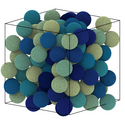

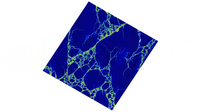

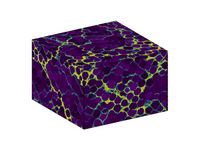

RHEO:
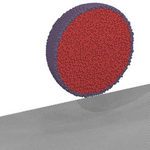

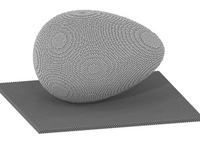

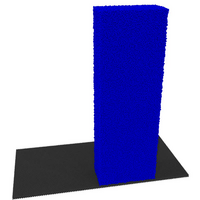

These papers have further details:
Critical Scaling of Solid Fragmentation at Quasistatic and Finite Strain Rates, J. T. Clemmer and M. O. Robbins, Physical Review Letters, 129, 078002 (2022). (abstract)
Exploring pressure-dependent inelastic deformation and failure in bonded granular composites: An energetic materials perspective, J. T. Clemmer, K. N. Long, and J. A. Brown, Mechanics of Materials, 184, 104693 (2023). (abstract)
A soft departure from jamming: the compaction of deformable granular matter under high pressures, J. T. Clemmer, J. M. Monti, and J. B. Lechman, Soft Matter, 20, 1702-1718 (2024). (abstract)
Reproducing Hydrodynamics and Elastic Objects: A Hybrid Mesh-Free Model Framework for Dynamic Multi-Phase Flows, E. T. Palermo, K. T. Wolf, J. T. Clemmer, and T. C. O’Connor, in review (2024). (abstract)
A hybrid smoothed-particle hydrodynamics model of oxide skins on molten aluminum, J. T. Clemmer, F. Pierce, T. C. O’Connor, T. D. Nevins, E. M. C. Jones, J. B. Lechman, J. Tencer, Applied Mathematical Modelling, 130, 310-326 (2024). (abstract)